Canon EF 600mm f/4 L IS USM Field Review
If you are interested in birds and wildlife, the Canon 600mm f/4 L IS USM is one of the best lenses that you can get. It gives all the reach you need; it has a wide aperture and it works well even with teleconverters, that give you a 840mm f/5.6 or a 1200 f/8. Thanks to the ultrasonic motor, the autofocus is fast and quiet, and you can even fine tune the AF in every moment using the full time manual focus. Image stabilization helps a lot to avoid motion blur, and it makes possible even handholding such large lens: the 600 f/4 is an unique lens, a real dream for the nature photographer.
Lens Specifications
����| � | � � |
�
| �Focal length | � �600 mm |
�
| �Lens construction | � �17 elements in 13 groups |
�
| �Number of Diaphragm Blades | � �8 blades |
�
| �Angle of view | � �2.87º(on APS-C camera); 4.13º (on 35mm camera) |
�
| �Max. Magnification | � �0.12x (1:8.3) |
�
| �Maximum Aperture | � �f/4 |
�
| �Minimum Aperture | � �f/32 |
�
| �Image stabilization | � �Yes |
�
| �Autofocus | � �Inner ultrasonic motor (ring-type USM) |
�
| �Full Time Manual Focus | � �Yes |
�
| �Closest Focusing Distance | � �5.50 meters |
�
| �Filter size | � �52 mm (Drop-In) |
�
| �Dimensions | � �168 x 456 mm |
�
| �Weight | � �5,360 g |
�
| �Weather sealing | � �Yes |
�
| �Price | � �$ 7400 |
�
| �Announced | � �1999 |
�
| �Accessories | � �Rear cap, front cap, lens hood (ET-160), tripod socket, lens case.� |
�
Description
The 600 f/4 is large, heavy and rock solid lens. The body is made of magnesium-alloy, and it is entirely weather sealed: this is clearly a lens made for heavy and continuous professional use. The front element is actually a flat glass, that can be easily replaced by a Canon Service Center, if it is damaged.
The lens has a robust, non-removable tripod collar. Usually this lens is mounted on professional tripods (if you want the most solid support, I'd recommend the
Gitzo GT 3541 LS or the
Gitzo GT 5541 LS with
Wimberley Head II), but if you are fit you can even handhold it, using the image stabilizer and relatively fast shutter speeds. Between the tripod collar and the mount there is a filter holder, where you can insert a gelatin filter. Even if you don't plan to use it (I know very few photographers that use filters with such lenses) you have the leave it in its place, because it is a part of the optical system, even without a filter.
Next to the tripod mount there is the control panel. The first switch is the Focus Limiter: you can choose between 5.5meters-infinity, 16.2mt-infinity, 5.5mt-16.2mt. Reducing the AF range improves the AF speed, and it is particularly useful in low light or with non-professional cameras. The second switch is for AF/MF. For wildlife photography, I use always autofocus: this lens has Full Time Manual Focus, too, so it is possible to focus manually in every moment, even if the focus switch is set on AF.
The image stabilizer has two switches. The first one allows to turn it on or off: I keep it on almost all the time. The manual supplied with the lens tells to turn off IS when you mount the lens on the tripod, but it depends by the situation: if the tripod and the tripod head are firmly locked it is better to turn off the stabilization, while if the head is unlocked it is better to keep on the stabilization. Remember that IS takes about 1 second to activate; when IS is turned on, you have to half-press the shutter release for at least 1 second before taking the photo, otherwise you don't get any benefit, and you may even get softer images than without IS. For more details about IS, I'd suggest give a look to the article about
image stabilization.
The second IS switch allows to select the IS Mode 1 or the IS Mode 2. The Mode 1 correct shake both horizontally and vertically, while Mode 2 acts only vertically (in theory, mode 2 is for panning). I always use Mode 1; in my opinion it is more effective.
The last switch works together with the "SET" button and the focus preset ring. The focus preset allows to memorize a distance, and to come back instantly to this distance when you turn the FP ring. To use the FP, set the switch on "|" (active) or "((" (active, with beep). Focus on the distance that you want to memorize and press the the SET button. Now, you can instantly come back to this distance turning the FP ring; if you have activated the FP in "((" the lens emits a little beep when the focus is achieved. I have never used the focus preset; in my opinion it is a quite useless feature.
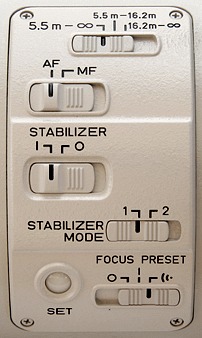
The focus ring is very large and smooth. Even though this lens is almost always used in autofocus, the MF ring helps to reduce the time for AF acquisition. In some situations (low light, low contrast subjects, etc), the AF takes some time to find the right subject, but you can improve AF acquisition by focusing roughly on the subject with manual focus. As already said, this lens has FTM, so you can use manual focus in every moment, even if the AF is turned on.
Next to the focus ring, there is a much slimmer ring: it is the already mentioned "Focus Present" ring. Rotate slightly this ring to move the focus on the memorized distance.
Next to the front of the lens there are four AF lock buttons: press one of them and the AF stay locked until you release the button. Personally, I find then very awkward to use on a long lens as the 600 IS: I much prefect to use the AF lock button on the body of the camera. The AF lock is very useful when you are photographing a still subjects: you can focus on the eye with the center AF sensor (the most precise one), then lock the focus and recompose the photo.
The lens hood is very large, but surprisingly light. It is also extremely expensive to replace (it cost more than an entry level DSLR!), so it better to don't lose or damage it. All Canon supertele don't have a real lens cap, but they use a leather-style cap that covers both the front element, the hood and nearly half of the lens body. I don't like at all this cap, and I have replaced it with the
LensCoat Hoodie, that has a better design.
The 600 f/4 is provided with
a very big carrying case, that is pretty large and almost heavier than the lens (it weights 6 kg). You can even lock the case with a couple of keys, and it can be carried both horizontally or vertically. This case is essentially useless: it is way too big and heavy to be used in the field, and I don't recommend to use it for air travel, because it screams "steal me!" ;-)
Similar Lenses (for Canon EOS)
Sigma has an unique super tele zoom, the
Sigma 300-800mm f/5.6 EX HSM. Even though it is a sharp and versatile lens, I'd not recommend it; it lacks of the image stabilization, the fast autofocus and the built quality of the Canon 600 IS. Sigma produces even the gigantic
Sigma 200-500mm f/2.8 EX: even though the idea of a 500mm f/2.8 (or 1000mm f/5.6) if attractive, the weight and size of this lens make it almost unusable. It weights 16.8 kg, it is 72 cm long and it costs $ 24000!
Canon has recently announced a supertele that offers even more reach than the 600: the
Canon EF 800mm f/5.6 L IS USM is currently the longest lens in the Canon lineup (the 1200mm f/5.6 has been discontinued some years ago, and when it was in production is was priced at $ 80000). It is 0.8 kg lighter than the 600, and it offers a slightly better image quality than 600 with teleconverters: it has less chromatic aberration and it is a bit sharper than 600 with 1.4x, as you can see in the excellent comparison made by Bryan Carnathan (
click here for Bryan's review and comparison). I have not seen yet any comparison of 800 + 1.4x vs 600 + 2x, but I expect to see about the same difference that you see in the previous test: obviously the 800 is a little better, since it is a more recent design and it starts at a longer focal length.
That said, the 800 has some disadvantages: it does not have the f/4 aperture of the 600, and it has an exaggerate price of $12000. Moreover, sometimes a focal length of 800mm may be too much. I recommend this lens only if you really need the maximum reach, and if you can afford its exorbitant price. Personally, I wouldn't hesitate to pick the 600 f/4 instead of the 800 f/5.6.
In my opinion, the only real alternative to the Canon 600 IS is the cheaper, smaller and lighter
Canon EF 500mm f/4 L IS USM. The Canon 500 f/4 is one of the best lenses for wildlife photography; in some respects, it is even better than the 600 f/4. The image quality is identical: they are both razor sharp, even with the 1.4x TC, and they are pretty good with the 2x TC. The autofocus is extremely fast; it focuses 1 meter closer than the 600 (4.5 meters instead of 5.5 mt), even though the reproduction ratio is the same since the 500 f/4 has a shorter focal length.
The biggest difference between the 500 and the 600 is weight and size: the 500 is smaller (146 x 387mm vs the 168 x 456mm of the 600) and much lighter (3.9kg vs 5.4kg). In practice, the difference is even more that what you can imagine from these numbers. Since the front element is smaller, it is easier to photograph from the small windows of many hides, and overall the smaller size of the lens makes much easier to carry it around. Moreover, if you travel by plane it is easier to carry it with you as carry-on luggage, while the 600 might exceed the size limits of some plane companies.
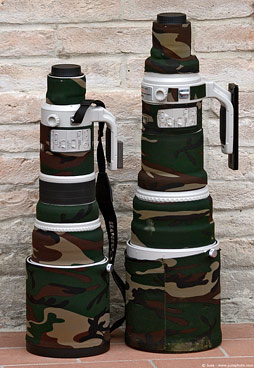
Side by side: the 500 f/4 and the 600 f/4. In practice, the difference is even more than what you might think from that photo.
The difference in weight between the 500 and the 600 is another advantage of the 500: you might think that "just" 1.5kg don't make much difference, but in practice there is a very noticeable difference. The 600 f/4 requires some strenght to be handhold, while the 500 is much easier to handhold. If you have a steady hand, you will be able to get regularly sharp photos with a shutter speed of 1/250 or faster.
The 500 has 100mm less focal length than the 600. This is not a night/day difference: if you are able to take a photo with the 600, it is likely that you will be able to take the photo even with the 500, moving a little closer to the subject or cropping a little more. On the other hand, with the 600 I tend to use less the TCs, while with the 500 I'd be temped more often to mount at least the 1.4x, losing one stop of light. Many wildlife subject are pretty shy and it is not easy to get closer so every bit of focal length helps, and it allows to get a slightly better image quality by reducing the need of cropping when you can not get closer.
���� �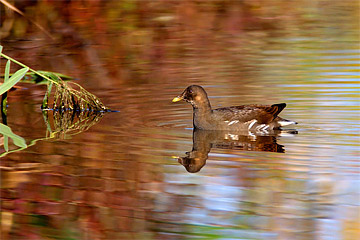 | � �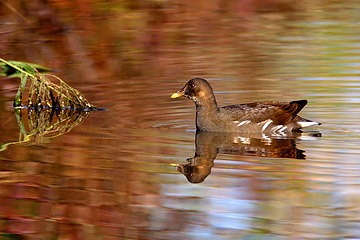 | �
�
These two photos simulates the reach difference between the 500 (left) and the 600 (right). It is not easy too choose between the reach of the 600 and the portability of the 500!
In conclusion, the choice between 500 and 600 is far from easy; if possible, I'd suggest to try both lenses before buying one of them. If you plan to travel a lot and to carry the lens for long distances, I'd recommend the 500, while if you want to photograph very shy subjects, in particular small birds, the 600 is a better choice. Personally, I've chosen the 600 because I wanted the maximum reach and I can live with its bulk (when I need a smaller and lighter lens, I use the 300 f/2.8 IS).
Image Quality (without TCs)
Remember that you can easily adjust color, distortion, chromatic aberration and vignetting with Photoshop; even though I list every aspect of image quality I don't consider these aspects as important as the other three that can not be corrected with Photoshop (sharpness, contrast and flare). You can enhance a little sharpness and contrast with PS, but the results are not as good as a photo taken with a lens that is sharp and contrasted.
The image samples has been taken in RAW format and converted with Photoshop CS3; I processed each photo to optimize the image quality (contrast, color, sharpness), and I saved them as high-quality JPEG for web display. You can download both the processed JPEG and the original, untouched RAW files. Click on the image to download the full size JPEG sample, or use the RAW link to download the untouched RAW (large file!). Please respect the copyright! This image can be printed only to evaluate the quality of the camera, for personal purposes. All other usages are prohibited.
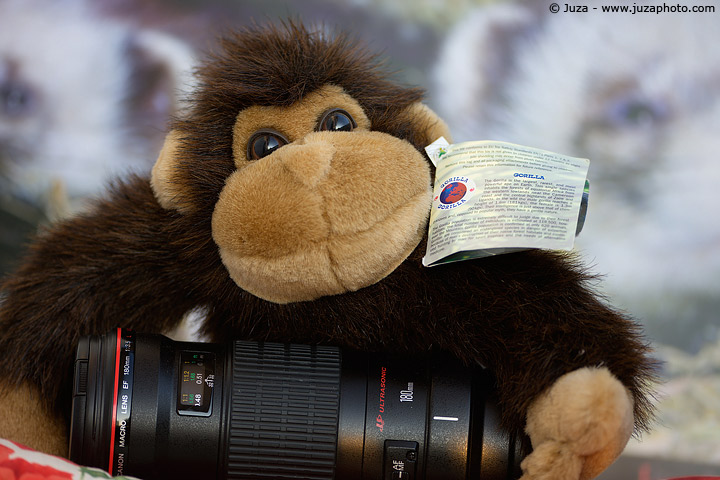
Gorilla at 600mm - Canon 600 4 IS, ISO 100, 1/40 f/4 JPEG / RAW - the 600 at its best. At f/4 the depth of field is shallow!
����| � | � � |
�
| �Sharpness | � �the sharpness is awesome from corner to corner, even wide open. This is truly one of the sharpest lenses ever made by Canon! |
�
| �Contrast | � �the contrast excellent, even wide open. |
�
| �Color | � �the colors are perfect, without any lens-introduced color cast. |
�
| �Flare | � �I have never had problems of flare with this lens. |
�
| �Distortion | � �there is not visible distortion. |
�
| �Chromatic aberration | � �there is just a little of CA, but it is barely noticeable, and very easy to remove. |
�
| �Vignetting | � �it has a very slight vignetting at f/4, that disappears at f/5.6 or f/8.� |
�
Overall, the image quality of the 600 f/4 could be described with a single word....outstanding! The Canon 600 IS has the potential to deliver superb image quality, even wide open at f/4. That said, it is not easy to fulfill the potential of this lens: you have to fight two great issues, the motion blur and the atmospheric distortion. To avoid motion blur, yoo need either fast shutter speed and good handholding techniques or a stable tripod. In the past I used the Gitzo 1548 with the Wimberley Head WH-200, while now I often handhold the lens, but I use fast shutter speeds to freeze both the movements of the subject and my movements.
The atmospheric distortion is an issue almost unknown to those who don't have a supertele. When you frame a very distant subject with a lens like the 600 IS, you "pass through" a lot of air. Humidity and heat waves can lower very much the image quality of the lens. In very warm days, the effect is impressive: if you frame a distant subject you can literally see the heat waves!
Usually, cold days allows to get the best image quality with distant subject, but at shorter distances (between 5 and 30 meters) usually you get good quality, even in warm days.
Image Quality (with Canon 1.4x TC)
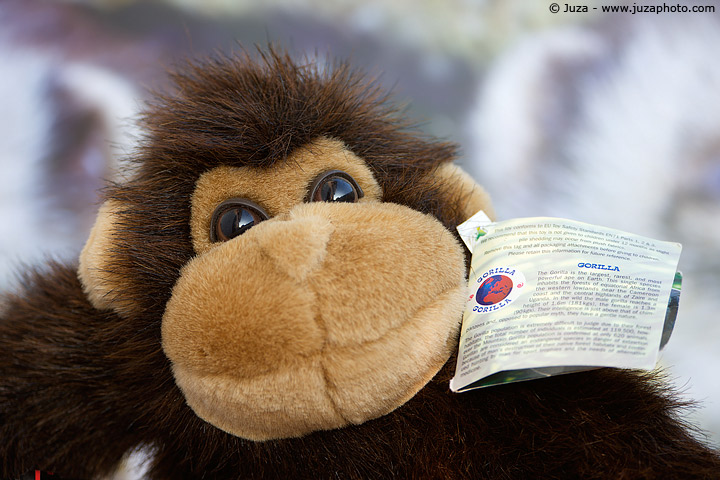
Gorilla at 840mm - Canon 600 4 IS, 1.4x TC, ISO 100, 1/20 f/5.6 JPEG / RAW - wide open with the 1.4x TC, at 840mm.
����| � | � � |
�
| �Sharpness | � �the sharpness is very good, even wide open. |
�
| �Contrast | � �the contrast very good, even wide open. |
�
| �Color | � �the colors are perfect, without any lens-introduced color cast. |
�
| �Flare | � �I have never had problems of flare with this lens. |
�
| �Distortion | � �there is not visible distortion. |
�
| �Chromatic aberration | � �the CA becomes more visible, in particular in the corners, but it is still a minor annoyance. |
�
| �Vignetting | � �There is a little of vignetting wide open, that disappears at f/8.� |
�
The Canon EF 1.4x TC is a fantastic accessory for this lens: it transform the 600 f/4 in a 840 f/5.6. All teleconverters reduce, more or less, the images quality, but with the 600 IS the loss of sharpness is truly minimal, even wide open (i.e. at f/5.6). I shoot almost always at f/5.6 with 600IS+1.4xTC, and I am very satisfied by the results. Of course, the two previously mentioned issues (motion blur and atmospheric distortion) are even more pressing, but if you manage to avoid them you can take awesome and unique photos.
Using the teleconverter is very straightforward: mount it on the lens, and then mount the camera on the lens/teleconverter combo. To remove the TC, first remove the camera, then press the release on the left side of the TC, and rotate it to the left. If you observe closely the TC, you will notice that it is weather sealed: it is an "L" lens in every respect, even if Canon don't use the "L" designation for teleconverters. The only downside of this TC is the unavoidable loss of 1 stop of light...the image quality, as already said, is excellent, and the AF remains pretty fast even for wildlife subjects. I use it on my 600 f4 for more than half of my photos.
Image Quality (with Canon 2.0x TC)
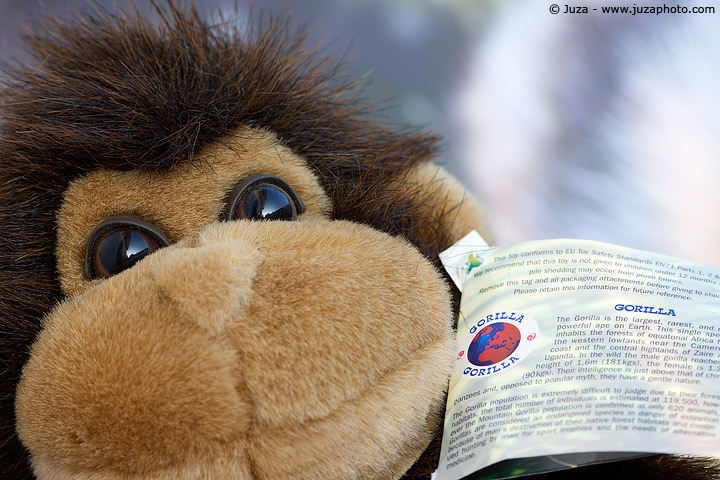
Gorilla at 1200mm - Canon 600 4 IS, 2.0x TC, ISO 100, 1/5 f/11 JPEG / RAW - with the 2.0x TC, stopped down by 1 stop.
����| � | � � |
�
| �Sharpness | � �the sharpness is acceptable wide open at f/8, but I recommend to stop down to f/11 to get the best detail, if there is enough light. |
�
| �Contrast | � �the contrast good at f/8, but it improves at f/11. |
�
| �Color | � �the colors are perfect, without any lens-introduced color cast. |
�
| �Flare | � �I have never had problems of flare with this lens. |
�
| �Distortion | � �there is not visible distortion. |
�
| �Chromatic aberration | � �there is a little of CA that is difficult to remove completely even with ACR; nevertheless, it is still acceptable, you would notice it only in large prints. |
�
| �Vignetting | � �There is a little of vignetting wide open, that disappears at f/11.� |
�
The Canon EF 2.0x doubles the reach of your lens: in other words, the 600 f/4 becomes a whopping 1200mm f/8!
Even if the loss of image quality with the 2x is more noticeable than with the 1.4x, the images are still good even wide open, and at f/11 - f/16 the sharpness is very good. I don't hesitate to use the 2x, when I need the reach of this TC, in particular with the 1DsIII, that maintains autofocus even at f/8.
In-depth look: performance with Teleconverters (Studio Test)
I'm not a fan of studio tests, because they reveal only part of the story - you have to try a lens in the field from weeks or months to know its actual performance. That said, I'll make an exception here, including a studio test in the 600 f/4 review: the purpose of this test is to show the (awesome) image quality that can be obtained with the 600 and TCs, in ideal conditions. All the images are 100 % crops, processed with Levels (contrast) and Smart Sharpen.
I choose a postage stamp as test target, since it has a lot of fine detail (in the images taken at 1200mm, you can actually see the dots of ink used for the drawing of the stamp!). This target allows to determine if the TC actually adds detail to the image, or if it just magnifies the image.
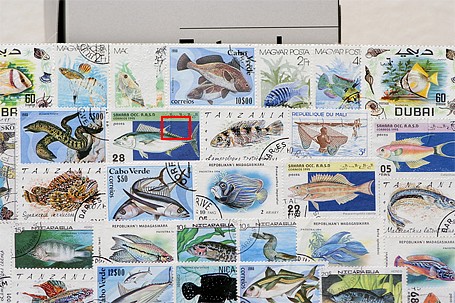
The photo above is the resized full frame (photographed with the 600 with no TCs); the red square shows the area of the crop. Of course the crops taken with TCs show a tighter area, since the distance camera-target was not changed.
����| � | � �Wide open | � �1 stop from wide open | � �2 stop from wide open |
�
| �no TC | � �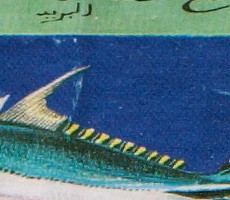 | � �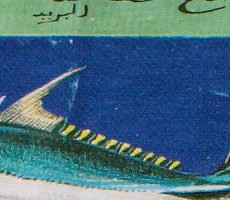 | � �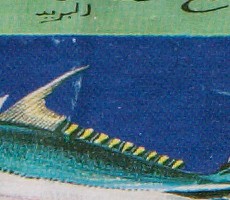 |
�
| � | � �600 mm at f/4
| � �600 mm at f/5.6
| � �600 mm at f/8
� |
�
����| � | � �Wide open | � �1 stop from wide open | � �2 stop from wide open |
�
| �1.4x | � �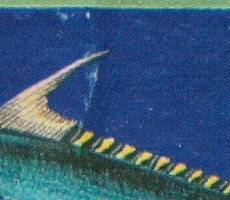 | � �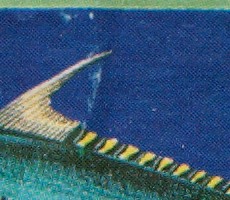 | � �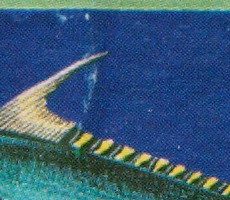 |
�
| � | � �840 mm at f/5.6
| � �840 mm at f/8
| � �840 mm at f/11
� |
�
����| � | � �Wide open | � �1 stop from wide open | � �2 stop from wide open |
�
| �2.0x | � �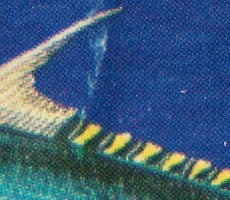 | � �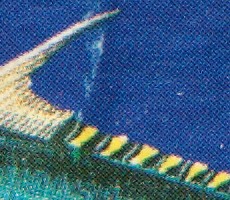 | � �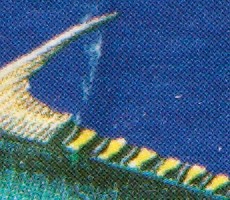 |
�
| � | � �1200 mm at f/8
| � �1200 mm at f/11
| � �1200 mm at f/16
� |
�
����| � | � �Wide open | � �1 stop from wide open | � �2 stop from wide open |
�
| �1.4x+2.0x | � �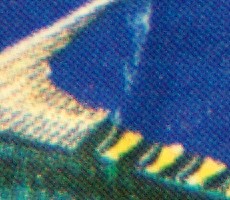 | � �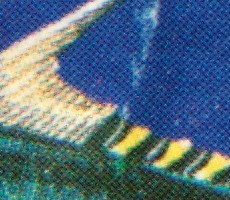 | � �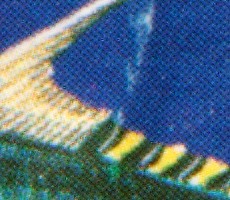 |
�
| � | � �1680 mm at f/11
| � �1680 mm at f/16
| � �1680 mm at f/22
� |
�
����| � | � �Wide open | � �1 stop from wide open | � �2 stop from wide open |
�
| �2.0x int | � �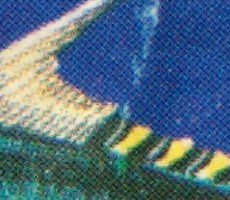 | � � | � � |
�
| � | � �1200 mm at f/11 (140%)
| � �1200 mm at f/11 (140%)
| � �1200 mm at f/11 (140%)
� |
�
With the bare lens, it is practically impossible to see an improvement from wide open to f/8 - it is razor sharp at every aperture. With the 1.4x, the widest aperture is just a tiny little softer than the two other samples - but it is impossible to tell the difference in the field. The 2.0x gives more distinct results - f/11 and f/16 are very sharp, while f/8 (wide open) is a bit softer, but still usable; it has clearly more detail than the sharpest 600+1.4x crop. Moreover, in the field the difference from 1200 f/8 and 1200 f/11 is much less apparent, since the faster shutter speed that you get at f/8 partially compensates for the slightly lower optical quality.
The stacked 1.4x+2.0x TCs are an extreme combination: I was really curious to see if they actually give more detail than an up-resized (interpolated) photo taken with 600+2x. For comparison, I included a last row of crops, that shows a detail from the image taken with 600+2x at f/11 (the sharpest aperture of this combination), up-resized by 140%. At f/11, the 600+1.4x+2x has clearly less detail than the interpolated 600+2x photo. At f/16, instead, the 600+1.4x+2x has more detail: this is the best aperture for the stacked TC combo. At f/22, the detail is nearly the same.
In practice, the 1680mm combo is nearly always softer than an up-resized 1200mm photo: remember that to get a real advantage in resolution, stacking the 1.4x to the 2.0x, you have to stop down to f/16...in studio it works, but in the field it is very difficult to avoid motion blur with a focal length of 1680mm at f/16.
In-depth look: Canon 600 f/4 IS with stacked teleconverters

Canon EOS 1Ds MarkIII, Canon EF 600mm f/4 L IS USM, Canon 1.4x TC, Canon 2.0x TC, 1/640 f/16, iso 800, handheld.
The previous studio test showed that stacked TCs, at f/16, gives a little more detail than a up-resized 1200mm f/11 photo. This result holds true in the field? I have tried in various occasions to use stacked TCs with the 600 f/4, both using the lens on Gitzo 1548 tripod or even handheld, but the 99% of times the results are disappointing.
The problem is not only optical quality - while stacked TC reduces considerably the sharpness, they have the potential to deliver a little more detail than 2x TCs. The real problem is atmospheric distortion: since the purpose of stacked TC is to take photos of very distant subjects, there is a lot of air between the lens and the subject, and it greatly reduces the image quality. Other than that, motion blur is often a problem, since you have to stop down at f/16 (at the widest aperture, f/11, the image quality is truly unusable).
The AF becomes very unreliable (even though it still works, on 1 series cameras) or it is completely turned off (on amateur and semi-pro Canon cameras); manual focus is very difficult, since the viewfinder is pretty dark at f/11.
In some rare cases you may get good results, as in the photo above (
click here to see a 100% crop), that has a surprisingly good sharpness considering the stacked TCs and the shooting conditions (extremely distant subject, handheld lens), but generally the downsides of stacked TC are much bigger than the advantages, and you will get only worse photos. I don't recommend to use stacked TCs on 600 f/4; it is better to shoot with the bare 2x and to crop a bit, if necessary.
Other Reviews
.
Canon EF 600mm f/4.0 L IS USM Review by The-Digital-Picture.com
.
Canon EF 600mm f/4.0 L IS USM Comments by Robert Royse
.
Canon EF 600mm f/4.0 L IS USM User Reviews su Fred Miranda Reviews
.
Canon EF 600mm f/4.0 L IS USM Review by Luminous Landscape
Conclusion
The Canon 600 f/4 is heavy and bulky, but it offers exceptional reach and first rate image quality, and it is one of the most desired lens by bird and wildlife photographers. It is fully usable even with teleconvertes, that give an excellent 840mm f/5.6 and a good 1200mm f/8. It has fast autofocus and a very effective and useful image stabilization; the built quality is first rate, as you can expect. It is not cheap in any way, but it is far less expensive than the 800 f/5.6; the only real alternative is the 500 f/4. If you are going to buy only one super tele lens, I think the 500 f/4 may be a better choice; otherwise, if you don't mind weight and size (or if you can afford to buy also the 300 f/2.8 as lightweight alternative), I
highly recommend the 600 f/4.

























 JuzaPhoto contains affiliate links from Amazon and Ebay and JuzaPhoto earn a commission in case of purchase through affiliate links.
JuzaPhoto contains affiliate links from Amazon and Ebay and JuzaPhoto earn a commission in case of purchase through affiliate links.